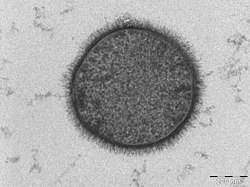Lipid bilayer
Lipid bilayers form cell membranes. They form a continuous sheet around all cells, and they surround most cell organelles. Lipid bilayers form automatically from phospholipids by self-assembly.
The phospholipids have heads which mix with water and tails which reject water. So the tails come together in the centre of the double layer, and the heads on the outside are surrounded by water.
The lipid bilayers stop most water-soluble (hydrophilic) molecules passing through. They also stop most ions.
In cells, proteins are put in the bilayer by enzymes. The proteins decide which molecules come in and which go out of the cell. For example, cells control salt concentrations and pH by pumping ions across their membranes using proteins called ion pumps.
Lipid Bilayer Media
Schematic cross sectional profile of a typical lipid bilayer. There are three distinct regions: the fully hydrated headgroups, the fully dehydrated alkane core and a short intermediate region with partial hydration. Although the head groups are neutral, they have significant dipole moments that influence the molecular arrangement.
TEM image of a bacterium. The furry appearance on the outside is due to a coat of long-chain sugars attached to the cell membrane. This coating helps trap water to prevent the bacterium from becoming dehydrated.
Transmission Electron Microscope (TEM) image of a lipid vesicle. The two dark bands around the edge are the two leaflets of the bilayer. Historically, similar images confirmed that the cell membrane is a bilayer
Human red blood cells viewed through a fluorescence microscope. The cell membrane has been stained with a fluorescent dye. Scale bar is 20 μm.
3d-Adapted AFM images showing formation of transmembrane pores (holes) in supported lipid bilayer
Illustration of a typical AFM scan of a supported lipid bilayer. The pits are defects in the bilayer, exposing the smooth surface of the substrate underneath.










